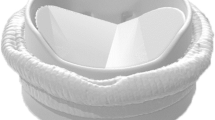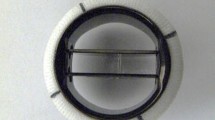Abstract
Diseased heart valves can be replaced with bileaflet mechanical heart valves (BMHVs), which may be affected by complications such as hemolysis, platelet activation and device failure. These complications are closely related to the characteristics of blood flow through mechanical valves and leaflet dynamics, and can become worse with tilted implantation of BMHVs. This study simulated the interactions of blood flow and leaflet motion for BMHVs implanted at different tilt angles. A fluid-structure interaction (FSI) method was employed to solve the problems of blood flow and leaflet motion interactively. A validation of the present numerical methods was performed against data produced in a previous work, indicating that the method presented in this study is reliable. Our results reveal detailed blood flow and leaflet motion in an aorta caused by the systole and diastole of the ventricle. As the tilt angle increased, the degree of asymmetry of blood flow and the time delay in the motions of the two different leaflets also increased, which may cause worsening of complications.
Similar content being viewed by others
References
J. Chandran, Pulsatile flow past a St. jude medical bileaflet heart, J. Thorac. Cardiovasc. Surg., 89 (1985a) 743.
Y. Woo and A. Yoganathan, Pulsatile flow velocity and shear stress measurements in the St. jude valve prosthesis, Scandinavian, J. Thorac. Cardiovasc. Surg., 20 (1986) 15–28.
J. Hasenkam, H. Mygaard, M. Giersiepen, H. Reul and H. Stodkilde-Jorgensen, Turbulent stress measurements downstream of six mechanical aortic valves in a pulsatile flow model, J. Biomechanics, 21 (1988) 631–645.
H. Nygaard, P. Paulsen, J. Hasenkam, E. Pedersen and P. Rovsing, Turbulent stresses downstream of three mechanical aortic valve prostheses in human beings, J. Thorac. Cardiovas. Surg., 107 (1994) 438–446.
T. Hung, R. HochMuth, J. Joist and S. Sutera, Shear induced aggregation and lysis of platelets, Trans, Amer. Soc. Artif. Int. Organs, 22 (1976) 285–291.
L. Leverett, J. Hellums, C. Alfrey and E. Lynch, Red blood cell damage by shear stress, Biophysical J., 2 (1972) 257–273.
M. Hartrumptf, J. Albes, T. Krempl, V. Rudolph and T. Wahlers, The hemodynamic performance of standard bileaflet valves is impaired by a tilted implantation position, Eur. J. Cardio-Thorac. Surg., 23 (2003) 283–291.
C. Choi and C. Kim, Analysis of blood flow interacted with leaflets in MHV in view of fluid-structure interaction, KSME J., 15 (2001) 613–622.
C. Choi, C. Kim and M. Choi, Characteristics of transient blood flow in MHVs with different maximum opening angles using fluid-structure interaction method, Korean J. Chem. Eng., 18 (2001) 809–815.
J. Bang, C. Choi and C. Kim, A numerical analysis on the curved bileaflet mechanical heart valve (MHV): Leaflet motion and blood flow in an elastic blood vessel, J. Mech. Sci. Technol., 19 (2005) 1761–1772.
K. Dumont, J. Vierendeels, R. Kaminsky, G. Nooten, P. Verdonck and D. Bluestein, Comparison of the hemodynamic and thrombogenic performance of two bileaflet mechanical heart valves using a CFD/FSI model, J. Biomech., 129 (2007) 558–565.
M. Nobili, U. Morbiducci, R. Ponzini, C. Gaudio, A. Balducci, M. Grigioni, M. Montevecchi and A. Redaelli, Numerical simulation of the dynamics of a bileaflet prosthetic heart valve using a fluid-structure interaction approach, J. Biomech., 41 (2008) 2539–2550.
J. Bang, S. Yoo and C. Kim, Characteristics of pulsatile blood flow through the curved bileaflet mechanical heart valve installed in two different types of blood vessels: velocity and pressure of blood flow, ASAIO J., 52 (2006) 234–242.
D. Bluestein, Y. Li and I. Krukenkamp, Free emboli formation in the wake of bi-leaflet mechanical heart valves and the effects of implantation techniques, J. Biomech., 35 (2002) 1533–1540.
Y. Alemu and D. Bluestein, Flow-induced platelet activation and damage accumulation in a mechanical heart valve: Numerical studies, Artif. Organs, 39 (2007) 677–688.
Author information
Authors and Affiliations
Corresponding author
Additional information
This paper was recommended for publication in revised form by Associate Editor Do Hyung Lee
Chang Nyung Kim is a Professor of the Department of Mechanical Engineering, College of Engineering, Kyung Hee University, Republic of Korea. He received his Ph.D in Mechanical Engineering at the University of California, Los Angeles. His research includes microfluid dynamics and environmental fluid dynamics.
Rights and permissions
About this article
Cite this article
Kim, C.N., Hong, T. The effects of the tilt angle of a bileaflet mechanical heart valve on blood flow and leaflet motion. J Mech Sci Technol 26, 819–825 (2012). https://doi.org/10.1007/s12206-011-1240-z
Received:
Revised:
Accepted:
Published:
Issue Date:
DOI: https://doi.org/10.1007/s12206-011-1240-z




